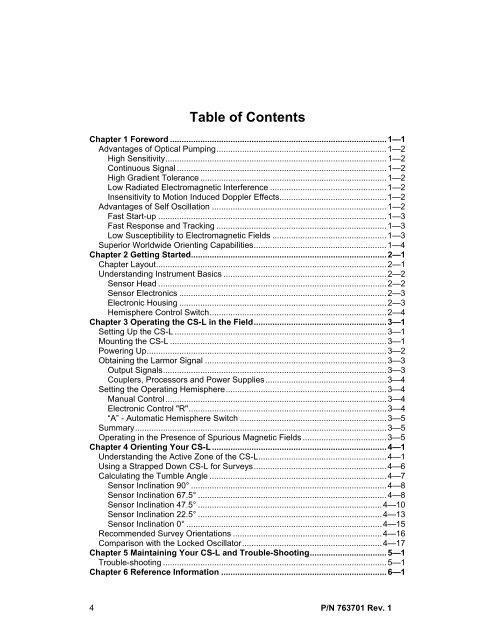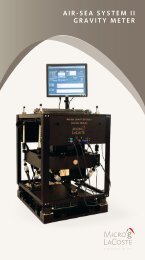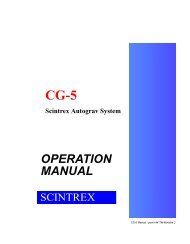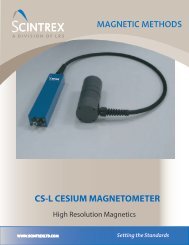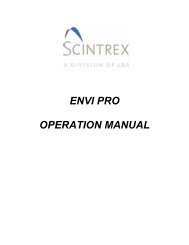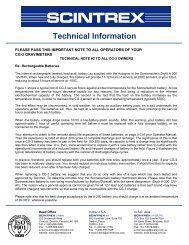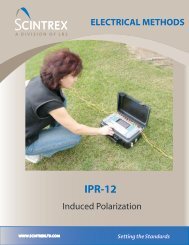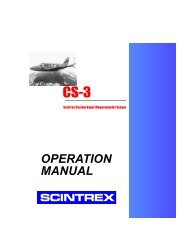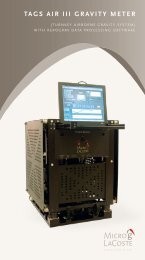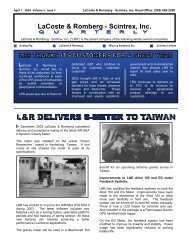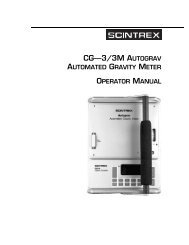CS-L Cesium Vapor Magnetometer Sensor OPERATION ... - Scintrex
CS-L Cesium Vapor Magnetometer Sensor OPERATION ... - Scintrex
CS-L Cesium Vapor Magnetometer Sensor OPERATION ... - Scintrex
You also want an ePaper? Increase the reach of your titles
YUMPU automatically turns print PDFs into web optimized ePapers that Google loves.
4<br />
Table of Contents<br />
Chapter 1 Foreword .............................................................................................1—1<br />
Advantages of Optical Pumping.........................................................................1—2<br />
High Sensitivity...............................................................................................1—2<br />
Continuous Signal ..........................................................................................1—2<br />
High Gradient Tolerance ................................................................................1—2<br />
Low Radiated Electromagnetic Interference ..................................................1—2<br />
Insensitivity to Motion Induced Doppler Effects..............................................1—2<br />
Advantages of Self Oscillation ...........................................................................1—2<br />
Fast Start-up ..................................................................................................1—3<br />
Fast Response and Tracking .........................................................................1—3<br />
Low Susceptibility to Electromagnetic Fields .................................................1—3<br />
Superior Worldwide Orienting Capabilities.........................................................1—4<br />
Chapter 2 Getting Started....................................................................................2—1<br />
Chapter Layout...................................................................................................2—1<br />
Understanding Instrument Basics ......................................................................2—2<br />
<strong>Sensor</strong> Head ..................................................................................................2—2<br />
<strong>Sensor</strong> Electronics .........................................................................................2—3<br />
Electronic Housing .........................................................................................2—3<br />
Hemisphere Control Switch............................................................................2—4<br />
Chapter 3 Operating the <strong>CS</strong>-L in the Field.........................................................3—1<br />
Setting Up the <strong>CS</strong>-L ...........................................................................................3—1<br />
Mounting the <strong>CS</strong>-L .............................................................................................3—1<br />
Powering Up.......................................................................................................3—2<br />
Obtaining the Larmor Signal ..............................................................................3—3<br />
Output Signals................................................................................................3—3<br />
Couplers, Processors and Power Supplies....................................................3—4<br />
Setting the Operating Hemisphere.....................................................................3—4<br />
Manual Control...............................................................................................3—4<br />
Electronic Control "R".....................................................................................3—4<br />
“A” - Automatic Hemisphere Switch ...............................................................3—5<br />
Summary............................................................................................................3—5<br />
Operating in the Presence of Spurious Magnetic Fields ....................................3—5<br />
Chapter 4 Orienting Your <strong>CS</strong>-L ...........................................................................4—1<br />
Understanding the Active Zone of the <strong>CS</strong>-L.......................................................4—1<br />
Using a Strapped Down <strong>CS</strong>-L for Surveys.........................................................4—6<br />
Calculating the Tumble Angle ............................................................................4—7<br />
<strong>Sensor</strong> Inclination 90° ....................................................................................4—8<br />
<strong>Sensor</strong> Inclination 67.5° .................................................................................4—8<br />
<strong>Sensor</strong> Inclination 47.5° ...............................................................................4—10<br />
<strong>Sensor</strong> Inclination 22.5° ...............................................................................4—13<br />
<strong>Sensor</strong> Inclination 0° ....................................................................................4—15<br />
Recommended Survey Orientations ................................................................4—16<br />
Comparison with the Locked Oscillator............................................................4—17<br />
Chapter 5 Maintaining Your <strong>CS</strong>-L and Trouble-Shooting.................................5—1<br />
Trouble-shooting ................................................................................................5—1<br />
Chapter 6 Reference Information .......................................................................6—1<br />
P/N 763701 Rev. 1


